
|
The Supersized File Format In Olympus C-5050Z and C-5060WZ cameras |

| My other pages related to the Olympus C-5050Z, C-5060WZ, and X-7070WZ |
|
This is a feature which allows you to save your image in a pixel size greater than the "native size" of the CCD, namely as a 3200x2400 JPEG file instead of the native 2560x1920 pixels. Only the Einsteins at the Olympus technical publications division know why this feature is referred to as "ENLARGE SIZE", all uppercase, in the manual (all other settings follow the normal English capitalization rules). To make things worse, the word "enlarge", as opposed to "enlarged" is used consistently in all references. This is enough, even for a semi-literate, poor immigrant like myself, to have serious doubts about the language skills of the said department. Well, maybe I should not be complaining: one of the respected digital camera reviewers stubbornly refers to shutter lag as "shutter LAG (sic!)", so maybe I'm really missing some intricate point here... The same people must be referring to sashimi as "RAW fish". My first reaction was to dismiss the feature as just a propaganda gimmick. Resizing the picture in-camera is a process similar to resizing it in the postprocessing, and in the latter case we have more memory, better processor, and, possibly, smarter rescaling algorithms, so why bother. Still, I had to check. You see, the CCD is really an array of separate light-sensitive cells (photosites) for each of the primary colors (50% for green, 25% each for red and blue), and the final image is produced by interpolation of the signal from these sensors (with R, G, and B light samples taken at slightly different locations) to the rectangular array of imaginary pixels, each of them containing all three components of the RGB information. Now, in order to "enlarge" the image size inside of the camera, two approaches are theoretically possible:
The first approach has an obvious advantage that the interpolation is done just once, which should result in losing less information (mostly sharpness). Obviously, an image processing program used off-camera can only use the second approach, dealing already with the transferred image. Thus, in theory at least, the in-camera resizing may give somewhat better results, but only under the assumption that it uses the first method. Here are results of a quick, informal check I performed to see what happens when we resize the picture inside the camera. Informal or not, it should be good enough, because any measurements are not really meaningful if you cannot see the difference in the picture. Using a tripod, I shot two frames of the same scene in Crofton, MD. Both were saved as SQH (1:4 compression) JPEG files; the first one in the native (2560x1920) resolution, the second one in the resized (3200x2400 pixels) format. First, let us have a look at the full-frame, reduced and re-sharpened pictures, shown to scale to give you a better idea on the size difference. |
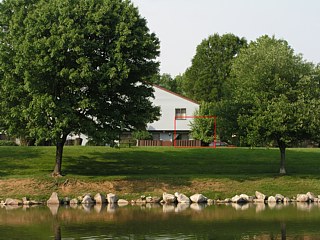
C-5050Z: aperture priority with -0.7 EV compensation, 1/400 s at F/4, sharpness, contrast, and color saturation at "normal', auto white balance. |

| |
|
Now, the moment of truth: the 1:1 fragments of both images, cropped but otherwise unaltered, and saved at a low JPEG compression to avoid any artifacts. This is how the pixel image really looks. The enlarged image shows a decent quality, although the amount of visible noise is somewhat higher than it could be explained just by a 25% (linear) size increase — look at the fence and, especially, the off-white window curtain. I suspect the in-camera resizing algorithm is followed by excessive sharpening. Some other artifacts can also be spotted, if you look really close. | ||
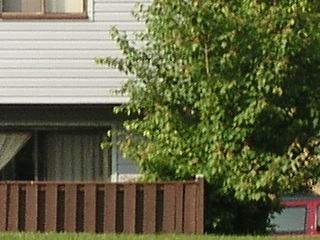
Above and right: Fragments of the images above, shown in full (1:1) pixel scale, without resizing or any other postprocessing. |
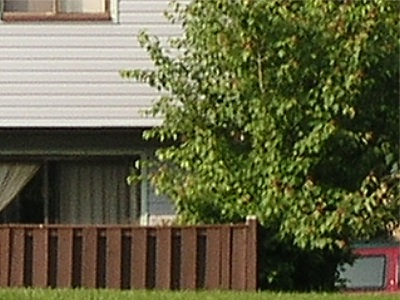
| |
|
A comparison like this does not, however, answer my original question: is the "enlarge (sic!) size" better than resizing the image in your computer? This is why I'm showing another sample at the right. It was generated by enlarging by 25% the native format sample (above left). In other words, I replaced the in-camera resizing with one done off-camera. This was done with use of my standard image editor, Corel Photo-Paint (Version 10), and no further processing (like sharpening or equalization) was involved. (If you are reading this on an LCD screen, see my remarks on sample viewing, as the first look may misleading because of different viewing angles.) |
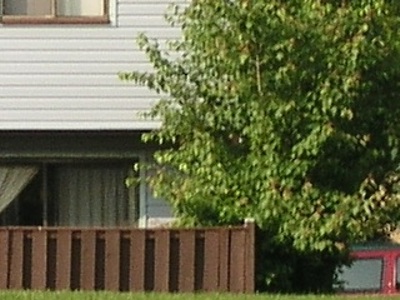
| |
|
If you rather would prefer more sharpness in the last image, it can be achieved by applying a touch of directional sharpening or unsharp mask in almost any graphic program. An example is shown in this picture. Compare it with the one two rows above, and there is no contest. Although some noise and edge artifacts have been added by the sharpening process, the image is clearly better than the one resized in-camera: both sharper and less noisy; that one looks crude by comparison. |
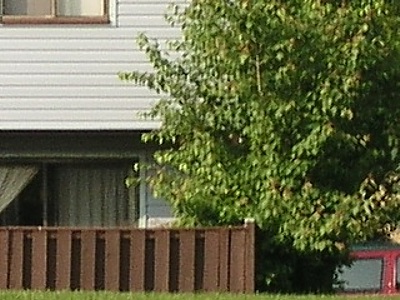
| |
|
Actually, I was expecting a better run for the money from the image resizing done in the camera. As it is, the verdict is quite easy: The in-camera image resizing in the C-5050Z is not useful. I suspect it is done as a secondary interpolation (i.e., after converting the photosite information into RGB pixel values), and it seems to be followed by rather excessive resharpening. The results are not really bad, but better results can be easily achieved at the postprocessing stage. I also suspect this "feature" was imposed on the Olympus engineering team (who, actually, succeeded in designing what I consider to be the best camera in its class) by the suits from the marketing team. Oh, well... And, last but not least, if you write me an email regarding this feature, do not use "ENLARGE SIZE" as the subject line. My spam filter will sent the message to the angels. | ||

| My other pages related to the Olympus C-5050Z, C-5060WZ, and X-7070WZ |
|
Camedia® and Olympus® are registered trademarks of Olympus Corporation.
This page is not sponsored or endorsed by Olympus (or anyone else) and presents solely the views of the author. |
| Home: wrotniak.net | Search this site | Change font size |
| Posted 2003/06/04 | Copyright © 2003 by J. Andrzej Wrotniak |